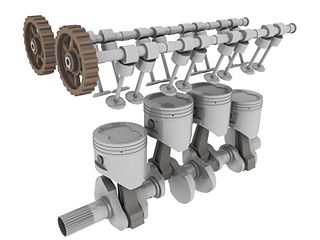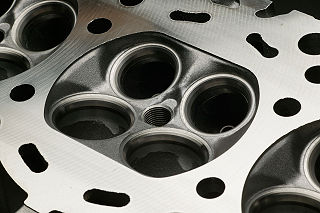
A V12 engine is a twelve-cylinder piston engine where two banks of six cylinders are arranged in a V configuration around a common crankshaft. V12 engines are more common than V10 engines. However, they are less common than V8 engines.

A V-twin engine, also called a V2 engine, is a two-cylinder piston engine where the cylinders are arranged in a V configuration and share a common crankshaft.

A V6 engine is a six-cylinder piston engine where the cylinders and cylinder blocks share a common crankshaft and are arranged in a V configuration.

The straight engine is a configuration of multi-cylinder piston engine where all of the cylinders are arranged in a single row, rather than radially or in two or more cylinder banks.

A V engine, sometimes called a Vee engine, is a common configuration for internal combustion engines. It consists of two cylinder banks—usually with the same number of cylinders in each bank—connected to a common crankshaft. These cylinder banks are arranged at an angle to each other, so that the banks form a "V" shape when viewed from the front of the engine.
The engine configuration describes the fundamental operating principles by which internal combustion engines are categorized.

A flat-twin engine is a two-cylinder internal combustion engine with the cylinders on opposite sides of the crankshaft. The most common type of flat-twin engine is the boxer-twin engine, where both pistons move inwards and outwards at the same time.

A flat-four engine, also known as a horizontally opposed-four engine or boxer engine, is a four-cylinder piston engine with two banks of cylinders lying on opposite sides of a common crankshaft. The most common type of flat-four engine is the boxer-four engine, each pair of opposed pistons moves inwards and outwards at the same time.

A straight-twin engine, also known as an inline-twin, vertical-twin, or parallel-twin, is a two-cylinder piston engine whose cylinders are arranged in a line along a common crankshaft.

A flat-twelve engine, also known as a horizontally opposed-twelve, is a twelve-cylinder piston engine with six cylinders on each side of a central crankshaft.

A straight-four engine is a four-cylinder piston engine where cylinders are arranged in a line along a common crankshaft.

A straight-three engine is a three-cylinder piston engine where cylinders are arranged in a line along a common crankshaft.

In automotive design, an RR, or rear-engine, rear-wheel-drive layout places both the engine and drive wheels at the rear of the vehicle. In contrast to the RMR layout, the center of mass of the engine is between the rear axle and the rear bumper. Although very common in transit buses and coaches due to the elimination of the drive shaft with low-floor buses, this layout has become increasingly rare in passenger cars.

A flat-six engine, also known as a horizontally opposed-six, is a six-cylinder piston engine with three cylinders on each side of a central crankshaft. The most common type of flat-six engine is the boxer-six engine, where each pair of opposed cylinders moves inwards and outwards at the same time. An alternative configuration for flat engines is a 180-degree V engine, where both cylinders move to the right then the left at the same time.

A multi-valve or multivalve engine is one where each cylinder has more than two valves. A multi-valve engine has better breathing, and with more smaller valves may be able to operate at higher revolutions per minute (RPM) than a two-valve engine, delivering more power.

A motorcycle engine is an engine that powers a motorcycle. Motorcycle engines are typically two-stroke or four-stroke internal combustion engines, but other engine types, such as Wankels and electric motors, have been used.

Stroke ratio, today universally defined as bore/stroke ratio, is a term to describe the ratio between cylinder bore diameter and piston stroke length in a reciprocating piston engine. This can be used for either an internal combustion engine, where the fuel is burned within the cylinders of the engine, or external combustion engine, such as a steam engine, where the combustion of the fuel takes place outside the working cylinders of the engine.
A flat-eight engine, also called a horizontally-opposed eight, is an eight-cylinder piston engine with two banks of four inline cylinders, one on each side of a central crankshaft, 180° apart.

A flat-sixteen engine, also known as a horizontally opposed-sixteen, is a sixteen-cylinder piston engine with eight cylinders on each side of a central crankshaft.

The Ferrari flat-12 engine family is a series of flat-12 DOHC petrol engines produced by Ferrari from 1964 to 1996. The first racing Ferrari flat-12, the Mauro Forghieri-designed Tipo 207, was introduced in the Ferrari 1512 F1 car in 1964. Later flat-12 racing engines were used in Ferrari Formula One and sports racing cars from 1968 until 1980, including the 212 E Montagna, 312 B series, 312 PB and 312 T series. The roadgoing flat-12 engines were introduced with the 365 GT4 BB and were produced in various versions until the end of F512M production in 1996.



























